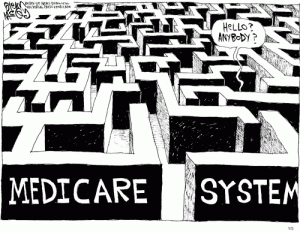By Jack Cumming
Recently by coincidence, I’ve attended two gatherings for the growing village movement. The first conference, on September 12 and 13, was hosted by the West Health Institute for California villages. The second, at the end of September, was a virtual meeting of the national organization.
Free Spirits
The tone of these meetings is very different from any other industry conference I’ve attended. First, there is an excitement and enthusiasm in the room that is palpable. The village movement is characterized by its grassroots origins in which people aging want to help each other to stay put and avoid what they perceive as “institutionalization.”
Second, there is not the concentration on vendors that you find at many senior living conferences. At the California meeting, there were four or five tables at the periphery, but a couple of those were genuine nonprofits committed to helping the unfortunate. None of them were staffed by professional salespeople.
Collaborate or Compete?
The village movement is new. It wasn’t visible in 2006 when my wife and I moved into a CCRC. Since its origin among neighbors in the Beacon Hill section of Boston, it has grown rapidly and now is spread across the country and beyond. Sitting there in the conference hall, soaking in the collaborative culture, I couldn’t help but think that these are the prime prospects for the senior living industry, and the industry isn’t present.
“Wouldn’t it make sense,” I thought, “for the industry to look for occupancy among a concentration of prospects?” Of course, it would, but the attendees are people who are bent on avoiding the kind of residency which the industry promotes. This is where it occurred to me that the opportunity that villages present is counterintuitive for a traditionally top-down industry.
Here’s how the reasoning goes. Villages do a good job with younger oldsters, but they struggle when people age into frailty, gullibility, or dependence. Villages also do a good job in building membership, but they falter with financial challenges. Hmmm. There’s an untapped synergy there that might help revive the senior living industry.
Collaboration
There’s no reason why CCRCs, for instance, cannot sponsor local villages. They might even do this by bringing residents and nonresidents together into a collaborative relationship that would look to the CCRC as its residential hub. That would make it natural for local community members to transition seamlessly to campus living as their needs change with aging.
But, wait, there’s more. Villages engage volunteers. Many villages have two categories, volunteers and members. Think of that. If volunteers took over positions like life enrichment and more, costs might drop dramatically for CCRCs. This new form of empowerment CCRC could have lower costs and a better aging experience as well.
Moreover, the grassroots nature of villages helps people to evolve into leadership roles. Resident leadership in CCRCs could help diminish the taint of CCRCs as institutionalization. Residents as voting members could dispel the impression that residents are disempowered and disenfranchised. That could be a win-win for all.
Control or Support?
That might seem like a reach too far for many who are most at home at conventional industry conferences. Those professionals are used to control and executive authority. The emerging model requires more dispersed empowerment.
With new model thinking, resident empowerment like that of the villages, with their grassroots origins and purpose, can become commonplace. Industry professionals would then serve more as support than as owners. This is in the DNA, say, of LCS. Life Care Services, an LCS company, provides management to 140 communities nationwide, serving approximately 40,000 seniors. Such a property management approach can work well with resident-governed communities.
The village grassroots model is also present in the growing interest in cohousing. One can easily envision a time when many of today’s CCRCs will adopt a cohousing/village concept to enhance their attractiveness in the market and to respond constructively to the growing wish of Americans to be able to age on their own terms without institutional oversight and control. That’s a model that could attract as participants even those industry executives who today savor top-down control.
There’s opportunity where many, perhaps most, now see only challenge. The difference is that villages don’t have to be sold. It’s what people want. Cohousing doesn’t have to be sold. It, too, is what cohousing residents want. That’s a big difference. And a positive one.









The idea of villages is top on my list. They should be everywhere
Jack, excellent perspective as usual. Much of what you describe is baked into the Cozy Home concept, including partnering with senior living operators with nearby full-service and/or skilled nursing and memory care resources. That way, someone living in a Cozy Home Community will have access to higher levels of care if needed.
Our first project is about to break ground in western Pennsylvania, with 46 detached small homes (1200 s/f, 2BR, 2BA) in four “colonies” where the residents are “members” and have roles and responsibilities. While there are the usual construction obstacles to navigate, the one area where we’re not concerned is in creating demand. We’re building what people want, especially at this stage of life — true community.
Thanks, Jack and Matt. These are exciting thoughts and ideas to consider for our recently incorporated seniors co-operative (Killick Coast North Seniors Co-operative) created based on the village model. Both, continuous care and communal living a la cohousing or cozy home colonies are thoughts for potential expansion of our co-op. I will do some more research myself, but if either of you can point me to CCRC or Cozy Home contacts in Canada (or even Newfoundland) that would be ideal. Thanks, Tom
Thomas, it’s so good to hear from you. I’m intrigued by the community you’re creating and would be happy to know more. I did visit your website at https://thomasmengel.com/aging-at-home-seniors-cooperative-killick-coast-north/. I think you’re on a good track. The challenges are the business aspects.
I also remember connecting with you on a recent Zoom. For those who may not know, Thomas Mengel lives in a unique corner of our converging world. When the Brits took over French Canada, two little islands, St. Pierre and Miquelon were left to the French and still today, they are part of France. What I didn’t know until I met Thomas is that there is a Canadian part of those islands, so he can drive from Canada to France without getting wet. Not many people can claim that.
Thanks for writing,, Thomas, let us know how your project goes and how wee can help.